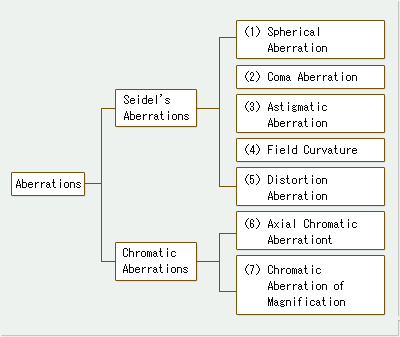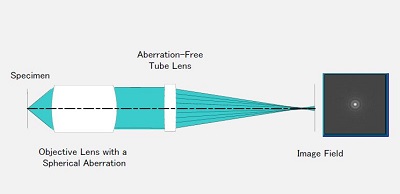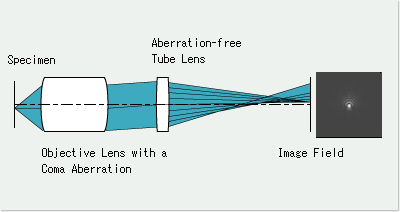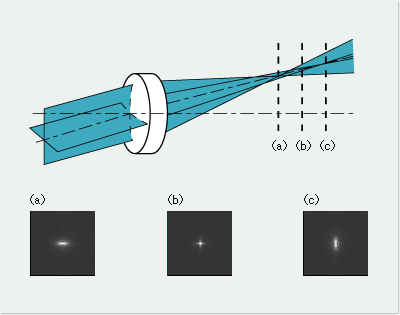Categorization of Aberrations
Aberrations that degrade the performance of image-forming are categorized as follows.
Seidel's Aberrations = "Spread of Image Points" + "Curvature of Field" + "Geometrical Distortion"
Above aberrations (1) to (3) signify "spread of image points" against requirement (i) for ideal image forming, aberration (4) signifies "curvature of field" against requirement (ii), and (5) signifies "geometrical distortion" against (iii). Also, aberrations (6) and (7) signify "chromatic blur" on an image caused depending on the characteristic of glass material used for an optical system. Meanwhile, to include the effect of diffraction of light, "spread of image points" may also be referred to as "wavefront aberration", also taking the phase into account with light assumed as "wave".
(1) Spherical Aberration
When light beams emitted from an object point on the axis are launched into a lens, the beams with a higher numerical aperture (N.A.) are refracted more greatly, crossing the optical axis away from the ideal image-forming position. An aberration due to variations of image-forming positions depending on the difference in numerical aperture (N.A.) of light beams on the axis is known as "spherical aberration". (A spherical aberration is proportional to the cube of a numerical aperture (N.A.).)

An objective lens is known to increase the resolving power as the numerical aperture (N.A.) increases, but this tends to deteriorate the spherical aberration. Olympus's objectives posses an excellent optical performance irrespective of high numerical aperture (N.A.) thanks to sophisticated design and production technologies.
(2) Coma Aberration
Even if a spherical aberration is corrected sufficiently small, the light beams emitted from the object points off the axis may not converge on one point in the image field, leaving an asymmetric blur with a trail like a comet. This aberration is known as "coma aberration".

(3) Astigmatic Aberration
An objective lens for which spherical and coma aberrations have been corrected may not be able to converge object points off the axis to a point, separating those points into a segment image in a concentric direction and that in a radial direction. This aberration is known as "astigmatic aberration". An objective with any astigmatic aberration will change the blur orientation of a point image to longitudinal or lateral with respect to before or after the focal point.

(4) Field Curvature Aberration
The image field of an object on a plane perpendicular to the optical axis is not always a flat surface perpendicular to the optical axis, but generally a curved surface. This phenomenon is called "field curvature aberration". If an objective lens has a field curvature aberration, an image will differ in position toward the periphery of a field of view. Therefore, if the center of the image is brought into focus, the periphery of the image becomes out of focus. To obtain a clear image up to the periphery, it is required to sufficiently correct this aberration.
(5) Distortion Aberration
A phenomenon in which the shape on an object plane will not become similar to that on an image field is known as "distortion aberration". An objective lens with any distortion aberration deforms a square image to a barrel shape or pincushion shape.

Microscope optical systems have a slight distortion aberration. This distortion aberration may cause a measurement error in geometric measurement.
(6) Chromatic Aberration
The glass used for an optical system has the property of being different in refractive index according to each wavelength of light. This causes a difference in focal length according to each wavelength, resulting in a deviation of image-forming position. This phenomenon is called "chromatic aberration". Particularly, an axial deviation of focal length on the optical axis is called "axial chromatic aberration" (also called lateral chromatic aberration) and a deviation on the image plane is called "chromatic aberration of magnification", respectively. Olympus takes an excellent corrective action against chromatic aberration using various types of glass. Chromatic aberration has been eliminated particularly from the apochromatic (MPlanApro) objective in a wide range between bluish-violet (g ray: wavelength 435nm) and red (C ray: wavelength 656nm).
Related Link
> Top of Digital Microscope page